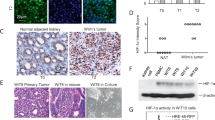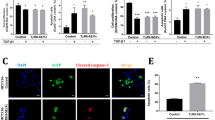Abstract
There are currently no effective therapies for cancer patients with advanced ovarian cancer, therefore developing an efficient and safe strategy is urgent. To ensure cancer-specific targeting, efficient delivery, and efficacy, we developed an ovarian cancer-specific construct (Survivin-VISA-hEndoyCD) composed of the cancer specific promoter survivin in a transgene amplification vector (VISA; VP16-GAL4-WPRE integrated systemic amplifier) to express a secreted human endostatin-yeast cytosine deaminase fusion protein (hEndoyCD) for advanced ovarian cancer treatment. hEndoyCD contains an endostatin domain that has tumor-targeting ability for anti-angiogenesis and a cytosine deaminase domain that converts the prodrug 5-fluorocytosine (5-FC) into the chemotherapeutic drug, 5-fluorouracil. Survivin-VISA-hEndoyCD was found to be highly specific, selectively express secreted hEndoyCD from ovarian cancer cells, and induce cancer-cell killing in vitro and in vivo in the presence of 5-FC without affecting normal cells. In addition, Survivin-VISA-hEndoyCD plus 5-FC showed strong synergistic effects in combination with cisplatin in ovarian cancer cell lines. Intraperitoneal (i.p.) treatment with Survivin-VISA-hEndoyCD coupled with liposome attenuated tumor growth and prolonged survival in mice bearing advanced ovarian tumors. Importantly, there was virtually no severe toxicity when hEndoyCD is expressed by Survivin-VISA plus 5-FC compared with CMV plus 5-FC. Thus, the current study demonstrates an effective cancer-targeted gene therapy that is worthy of development in clinical trials for treating advanced ovarian cancer.
This is a preview of subscription content, access via your institution
Access options
Subscribe to this journal
Receive 50 print issues and online access
$259.00 per year
only $5.18 per issue
Buy this article
- Purchase on Springer Link
- Instant access to full article PDF
Prices may be subject to local taxes which are calculated during checkout






Similar content being viewed by others
References
Jemal A, Siegel R, Xu J, Ward E . Cancer statistics, 2010. CA Cancer J Clin 2010; 60: 277–300.
Miller DS, Blessing JA, Krasner CN, Mannel RS, Hanjani P, Pearl ML et al. Phase II evaluation of pemetrexed in the treatment of recurrent or persistent platinum-resistant ovarian or primary peritoneal carcinoma: a study of the Gynecologic Oncology Group. J Clin Oncol 2009; 27: 2686–2691.
Gunther M, Wagner E, Ogris M . Specific targets in tumor tissue for the delivery of therapeutic genes. Curr Med Chem Anticancer Agents 2005; 5: 157–171.
Altieri DC . Validating survivin as a cancer therapeutic target. Nat Rev Cancer 2003; 3: 46–54.
Li F, Ling X . Survivin study: an update of ‘what is the next wave’? J Cell Physiol 2006; 208: 476–486.
Sui L, Dong Y, Ohno M, Watanabe Y, Sugimoto K, Tokuda M . Survivin expression and its correlation with cell proliferation and prognosis in epithelial ovarian tumors. Int J Oncol 2002; 21: 315–320.
Zaffaroni N, Pennati M, Daidone MG . Survivin as a target for new anticancer interventions. J Cell Mol Med 2005; 9: 360–372.
Bell D, Berchuck A, Birrer M, Chien J, Cramer DW, Dao F et al. Integrated genomic analyses of ovarian carcinoma. Nature 2011; 474: 609–615.
Mirza A, McGuirk M, Hockenberry TN, Wu Q, Ashar H, Black S et al. Human survivin is negatively regulated by wild-type p53 and participates in p53-dependent apoptotic pathway. Oncogene 2002; 21: 2613–2622.
Sher YP, Tzeng TF, Kan SF, Hsu J, Xie X, Han Z et al. Cancer targeted gene therapy of BikDD inhibits orthotopic lung cancer growth and improves long-term survival. Oncogene 2009; 28: 3286–3295.
Iyer M, Wu L, Carey M, Wang Y, Smallwood A, Gambhir SS . Two-step transcriptional amplification as a method for imaging reporter gene expression using weak promoters. Proc Natl Acad Sci USA. 2001; 98: 14595–14600.
Zhang L, Johnson M, Le KH, Sato M, Ilagan R, Iyer M et al. Interrogating androgen receptor function in recurrent prostate cancer. Cancer Res 2003; 63: 4552–4560.
Glover CP, Bienemann AS, Heywood DJ, Cosgrave AS, Uney JB . Adenoviral-mediated high-level, cell-specific transgene expression: a SYN1-WPRE cassette mediates increased transgene expression with no loss of neuron specificity. Mol Ther 2002; 5: 509–516.
Zufferey R, Donello JE, Trono D, Hope TJ . Woodchuck hepatitis virus posttranscriptional regulatory element enhances expression of transgenes delivered by retroviral vectors. J Virol 1999; 73: 2886–2892.
Lang JY, Hsu JL, Meric-Bernstam F, Chang CJ, Wang Q, Bao Y et al. BikDD eliminates breast cancer initiating cells and synergizes with lapatinib for breast cancer treatment. Cancer Cell 2011; 20: 341–356.
Xie X, Hsu JL, Choi MG, Xia W, Yamaguchi H, Chen CT et al. A novel hTERT promoter-driven E1A therapeutic for ovarian cancer. Mol Cancer Ther 2009; 8: 2375–2382.
Xie X, Xia W, Li Z, Kuo HP, Liu Y, Ding Q et al. Targeted expression of BikDD eradicates pancreatic tumors in noninvasive imaging models. Cancer Cell 2007; 12: 52–65.
Olson TA, Mohanraj D, Carson LF, Ramakrishnan S . Vascular permeability factor gene expression in normal and neoplastic human ovaries. Cancer Res 1994; 54: 276–280.
Yoneda J, Kuniyasu H, Crispens MA, Price JE, Bucana CD, Fidler IJ . Expression of angiogenesis-related genes and progression of human ovarian carcinomas in nude mice. J Natl Cancer Inst 1998; 90: 447–454.
Dixelius J, Larsson H, Sasaki T, Holmqvist K, Lu L, Engstrom A et al. Endostatin-induced tyrosine kinase signaling through the Shb adaptor protein regulates endothelial cell apoptosis. Blood 2000; 95: 3403–3411.
Sim BK, MacDonald NJ, Gubish ER . Angiostatin and endostatin: endogenous inhibitors of tumor growth. Cancer Metastasis Rev 2000; 19: 181–190.
Dixelius J, Cross M, Matsumoto T, Sasaki T, Timpl R, Claesson-Welsh L . Endostatin regulates endothelial cell adhesion and cytoskeletal organization. Cancer Res 2002; 62: 1944–1947.
Kim YM, Jang JW, Lee OH, Yeon J, Choi EY, Kim KW et al. Endostatin inhibits endothelial and tumor cellular invasion by blocking the activation and catalytic activity of matrix metalloproteinase. Cancer Res 2000; 60: 5410–5413.
Abdollahi A, Hahnfeldt P, Maercker C, Grone HJ, Debus J, Ansorge W et al. Endostatin's antiangiogenic signaling network. Mol Cell 2004; 13: 649–663.
Ou-Yang F, Lan KL, Chen CT, Liu JC, Weng CL, Chou CK et al. Endostatin-cytosine deaminase fusion protein suppresses tumor growth by targeting neovascular endothelial cells. Cancer Res 2006; 66: 378–384.
Hydzik C . Treatment of ovarian cancer with intraperitoneal chemotherapy. Oncology (Williston Park) 2009; 23: 15–20.
Markman M . An update on the use of intraperitoneal chemotherapy in the management of ovarian cancer. Cancer J 2009; 15: 105–109.
Templeton NS, Lasic DD, Frederik PM, Strey HH, Roberts DD, Pavlakis GN . Improved DNA: liposome complexes for increased systemic delivery and gene expression. Nat Biotechnol 1997; 15: 647–652.
Kish JA, Ensley JF, Jacobs JR, Binns P, al-Sarraf M . Evaluation of high-dose cisplatin and 5-FU infusion as initial therapy in advanced head and neck cancer. Am J Clin Oncol 1988; 11: 553–557.
Tanaka T, Masuda H, Naito M, Tamai H . Pretreatment with 5-fluorouracil enhances cytotoxicity and retention of DNA-bound platinum in a cisplatin resistant human ovarian cancer cell line. Anticancer Res 2001; 21: 2463–2469.
Kievit E, Bershad E, Ng E, Sethna P, Dev I, Lawrence TS et al. Superiority of yeast over bacterial cytosine deaminase for enzyme/prodrug gene therapy in colon cancer xenografts. Cancer Res 1999; 59: 1417–1421.
Zhang M, Li S, Nyati MK, DeRemer S, Parsels J, Rehemtulla A et al. Regional delivery and selective expression of a high-activity yeast cytosine deaminase in an intrahepatic colon cancer model. Cancer Res 2003; 63: 658–663.
Erbs P, Regulier E, Kintz J, Leroy P, Poitevin Y, Exinger F et al. In vivo cancer gene therapy by adenovirus-mediated transfer of a bifunctional yeast cytosine deaminase/uracil phosphoribosyltransferase fusion gene. Cancer Res 2000; 60: 3813–3822.
Chen CT, Yamaguchi H, Lee HJ, Du Y, Lee HH, Xia W et al. Dual targeting of tumor angiogenesis and chemotherapy by endostatin-cytosine deaminase-uracil phosphoribosyltransferase. Mol Cancer Ther 2011; 10: 1327–1336.
Parsons SL, Lang MW, Steele RJ . Malignant ascites: a 2-year review from a teaching hospital. Eur J Surg Oncol 1996; 22: 237–239.
Subramanian IV, Bui Nguyen TM, Truskinovsky AM, Tolar J, Blazar BR, Ramakrishnan S . A deno-associated virus-mediated delivery of a mutant endostatin in combination with carboplatin treatment inhibits orthotopic growth of ovarian cancer and improves long-term survival. Cancer Res 2006; 66: 4319–4328.
Ramirez RD, Sheridan S, Girard L, Sato M, Kim Y, Pollack J et al. Immortalization of human bronchial epithelial cells in the absence of viral oncoproteins. Cancer Res 2004; 64: 9027–9034.
Yu D, Wolf JK, Scanlon M, Price JE, Hung MC . Enhanced c-erbB-2/neu expression in human ovarian cancer cells correlates with more severe malignancy that can be suppressed by E1A. Cancer Res 1993; 53: 891–898.
Pisano R, Breda M, Grassi S, James CA . Hydrophilic interaction liquid chromatography-APCI-mass spectrometry determination of 5-fluorouracil in plasma and tissues. J Pharm Biomed Anal 2005; 38: 738–745.
Chou TC, Talalay P . Quantitative analysis of dose-effect relationships: the combined effects of multiple drugs or enzyme inhibitors. Adv Enzyme Regul 1984; 22: 27–55.
Acknowledgements
This work was supported by grants from National Science Council (NSC100-3112-B-039-003), Private University (NSC99-2314-B-039-029-MY3 to Y-PS and NSC99-2632-B to M-CH), Department of Health Cancer Research Center of Excellence (DOH99-TD-C-111-005), and The Sister Institution Fund of China Medical University and Hospital and The University of Texas MD Anderson Cancer Center.
Author information
Authors and Affiliations
Corresponding author
Ethics declarations
Competing interests
A patent application has been filed for EndoCD and the technology been licensed to a biotech company for development.
Additional information
Supplementary information accompanies the paper on the Oncogene website
Supplementary information
Rights and permissions
About this article
Cite this article
Sher, YP., Chang, CM., Juo, CG. et al. Targeted endostatin-cytosine deaminase fusion gene therapy plus 5-fluorocytosine suppresses ovarian tumor growth. Oncogene 32, 1082–1090 (2013). https://doi.org/10.1038/onc.2012.134
Received:
Revised:
Accepted:
Published:
Issue Date:
DOI: https://doi.org/10.1038/onc.2012.134
Keywords
This article is cited by
-
Therapeutic effects of statins against lung adenocarcinoma via p53 mutant-mediated apoptosis
Scientific Reports (2019)
-
ADAM9 promotes lung cancer progression through vascular remodeling by VEGFA, ANGPT2, and PLAT
Scientific Reports (2017)
-
Cytotoxic effect of co-expression of human hepatitis A virus 3C protease and bifunctional suicide protein FCU1 genes in a bicistronic vector
Molecular Biology Reports (2017)



